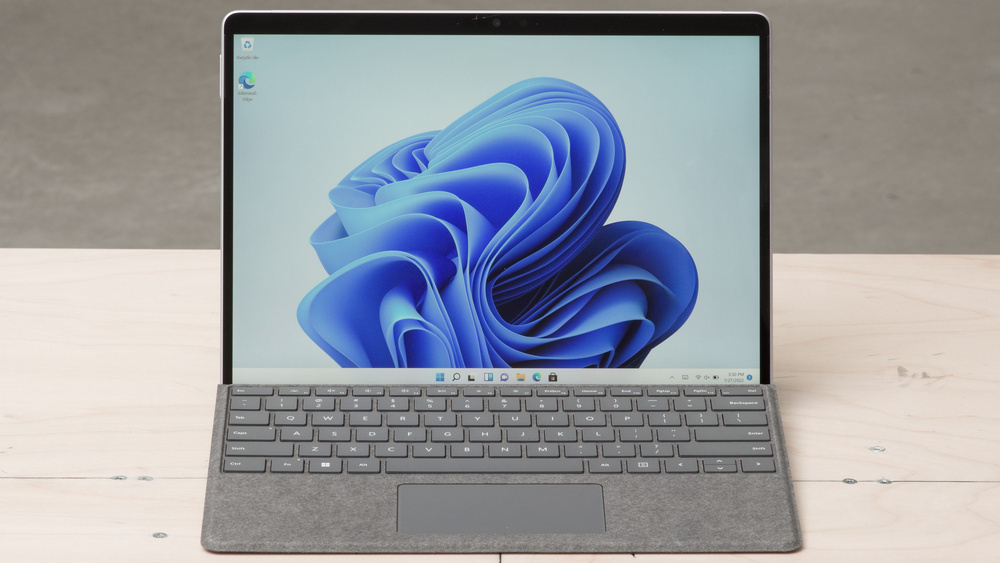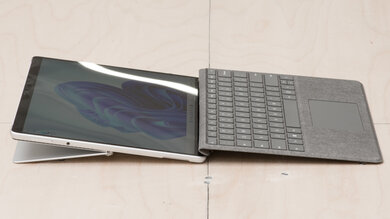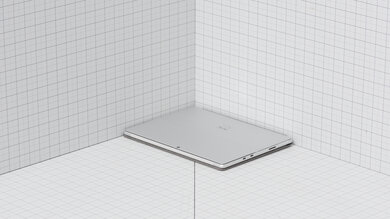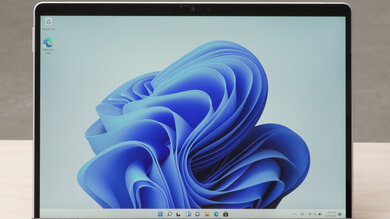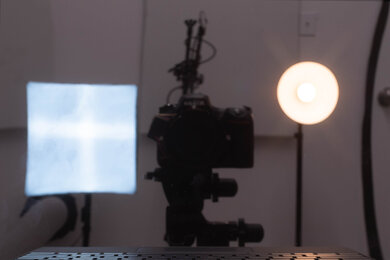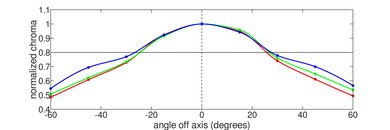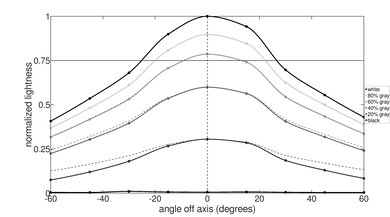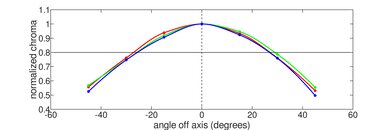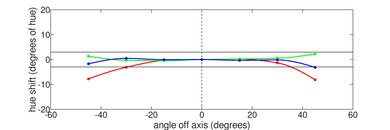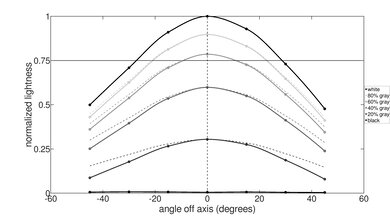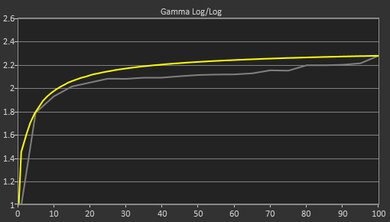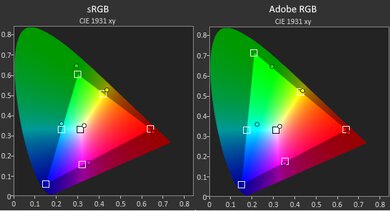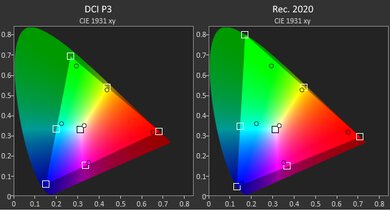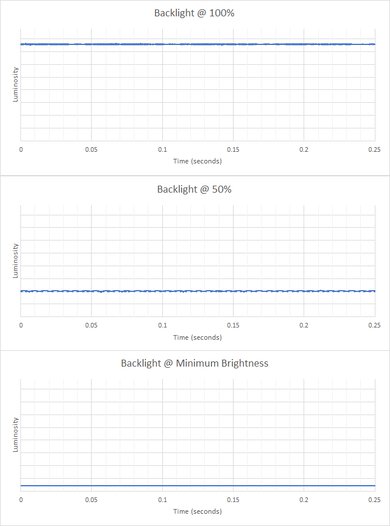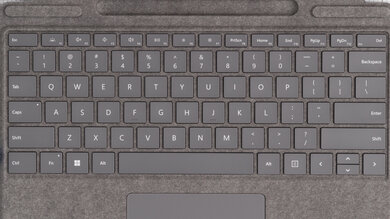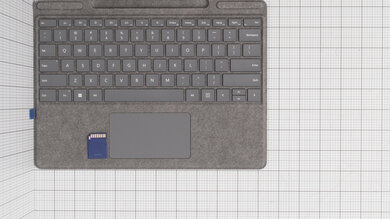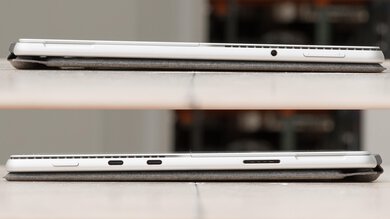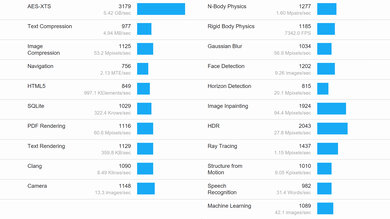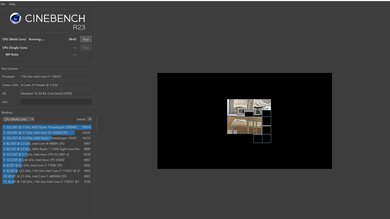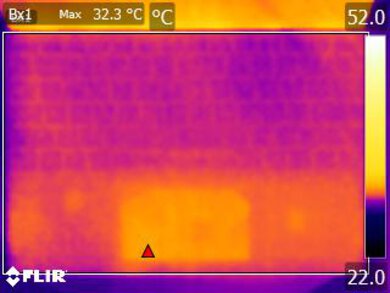The Microsoft Surface Pro 8 (2021) is a Windows tablet PC with a built-in kickstand and detachable keyboard. It replaces the Surface Pro 7 released in 2019. This new model has a new design, sporting a larger 13-inch display (up from 12.3-inch) as well as thinner bezels and more rounded edges, bringing its design closer to that of the Surface Pro X, Microsoft's ARM-based Surface Pro. It also has a new 120Hz display with Dynamic Refresh Rate support, meaning it can adjust the refresh rate dynamically to improve responsiveness or extend battery life. It's available with Intel 11th Gen CPUs, integrated graphics, up to 32GB of memory, and 1TB of storage. It has two USB-C/Thunderbolt 4 ports, a 1080p webcam, and an IR camera for Windows Hello facial recognition. Lastly, it has a new type of cover keyboard with a slot at the top to store and charge the Microsoft Surface Slim Pen 2, but you still need to buy the keyboard and pen separately.
See our unit's specifications and the available configuration options in the Differences Between Variants section.
Our Verdict
The Microsoft Surface Pro is a good laptop for school use. It feels very well-built and is easy to carry around since it's thin and lightweight. It has a nice sharp display, a comfortable keyboard, and a small but responsive touchpad. Its Intel CPU and integrated graphics can only handle general productivity tasks like text processing and web browsing, so it isn't ideal for students in fields like 3D animation. Unfortunately, you'll likely need to carry a charger when you're out and about, as its battery lasts around seven hours of light use.
- Easy to carry around.
- Sturdy build.
- Keyboard feels great to type on.
- Excellent 1080p webcam.
- Battery lasts only a little over seven hours of light productivity.
- Touchpad is on the small side.
- Low-power CPU and Integrated GPU can't handle demanding tasks.
- Limited port selection.
The Microsoft Surface Pro is okay for gaming. It has a 120Hz display with a fast response time to deliver a clear image in fast-moving scenes, and it supports VRR to reduce screen tearing. However, its low-power CPU and integrated graphics can't handle demanding games. You can get a decent gaming experience if you connect an external GPU via its Thunderbolt 4 port, though that's a separate purchase and an expensive one at that. Otherwise, you can only play lighter puzzle-like games or older titles, and even then, you'll likely need to lower the graphical settings to get smooth gameplay.
- 120Hz screen displays clear image in fast-moving scenes.
- Fast, user-upgradeable storage drive.
- Low-power CPU and Integrated GPU can't handle demanding tasks.
- RAM isn't upgradeable.
- Limited port selection.
The Microsoft Surface Pro laptop is good for media consumption. It's lightweight and easy to carry around, so you can easily watch videos while roaming around your home. Its high-resolution screen is vibrant and bright, though it isn't the best for dark room viewing, as its low contrast makes blacks look gray. The speakers sound good overall; they just don't get very loud. Unfortunately, its battery can't quite last six hours of video playback, so you likely can't binge-watch your favorite shows without plugging it in.
- Easy to carry around.
- Bright and sharp display.
- Can detach keyboard to save space when consuming media.
- Speakers sound clear.
- Battery lasts less than six hours of video playback.
- Blacks look gray in dim settings.
- Speakers don't get very loud.
The Microsoft Surface Pro is decent as a workstation. It's only available with low-power CPUs and integrated graphics, which aren't powerful enough to handle demanding workloads like 3D renders, video editing, or complex computations. Also, the CPU throttles under load, further reducing performance. Its port selection is limited, but thankfully, its USB-C ports support Thunderbolt 4, allowing you to transfer files quickly and connect up to two 4k @ 60Hz displays with a single cable.
- Fast, user-upgradeable storage drive.
- Two Thunderbolt 4 ports.
- Low-power CPU and Integrated GPU can't handle demanding tasks.
- RAM isn't upgradeable.
- CPU noticeably throttles.
- Limited port selection.
The Microsoft Surface Pro 8 is decent for business use. It has a compact, lightweight design that makes it easy to carry around. You can configure it with an Intel 11th Gen Core i5 or i7 CPU, which are fast enough to handle productivity tasks like text processing and spreadsheets. It also provides a great user experience with its sharp display, comfortable keyboard, and outstanding 1080p webcam. Unfortunately, it only has two USB-C ports, so you may need an adapter or dock if you want to connect multiple peripherals. Also, its battery doesn't last a full eight-hour workday.
- Easy to carry around.
- Sturdy build.
- Keyboard feels great to type on.
- Excellent 1080p webcam.
- Battery lasts only a little over seven hours of light productivity.
- Touchpad is on the small side.
- Limited port selection.
Changelog
- Updated Aug 14, 2024: Added mention of the Microsoft Surface Pro 11th Edition (2024) as an alternative with longer battery life in the Battery section.
- Updated Feb 19, 2024: We've updated the review for clarity and readability.
- Updated Dec 07, 2023: Converted to Test Bench 0.8.2.
- Updated Nov 03, 2023: Converted to Test Bench 0.8.1.
Differences Between Sizes And Variants
We tested the Microsoft Surface Pro 8 (2021) in the Platinum color scheme with an Intel Core i7-1185G7 CPU, integrated Intel Iris Xe Graphics, 16GB of RAM, and a 256GB SSD. The CPU, memory, and storage are configurable; the available options are in the table below.
| Screen |
|
|---|---|
| CPU |
|
| GPU |
|
| RAM |
|
| Storage |
|
| Color |
|
See our unit's label here.
Popular Laptop Comparisons
The Microsoft Surface Pro 8 is one of the best laptops of its kind. The Surface Pro lineup popularized the 2-in-1 tablet form factor, providing a premium user experience that similar devices from other manufacturers still can't match. Its versatility and compact design make it a great choice for school, work, and media consumption.
For more options, check out our recommendations for the best laptops, the best business laptops, and the best laptops for college.
The Microsoft Surface Pro 11th Edition (2024) is a newer version of the Microsoft Surface Pro 8 (2021). Though similar in design, the 11th Edition has quite a few changes, as it's now available with an OLED display and runs on an ARM-based SoC. The new model's Snapdragon SoCs are faster than the Surface Pro 8's Intel 11th Gen CPUs. However, because the Snapdragon chips are ARM-based processors, many apps might not run properly, so you need to ensure that the apps you use are compatible. Microsoft's new Surface Pro Flex keyboard (released at the same time as the 11th Edition Surface Pro) also brings new features, like a haptic touchpad and Bluetooth connectivity; the latter lets you use the keyboard when detached from the device, giving you more flexibility in how you use and position the device. Unfortunately, the 11th Edition's display exhibits a screen door effect caused by its digitizer, which might bother some people.
The Microsoft Surface Go 3 (2021) and the Microsoft Surface Pro 8 (2021) are both Windows tablets with detachable keyboards. The Surface Pro is better overall; it has a sharper, brighter, more color-accurate display with a 120Hz refresh rate, a better-spaced keyboard and larger touchpad, and two USB-C ports that both support Thunderbolt 4. Also, the Surface Pro is available with more powerful Intel Core i5 and i7 CPUs, and it has a user-replaceable SSD. The Surface Go is lighter and more compact, so it's easy to bring around, but its screen flickers below 100% brightness, which can cause eye strain and headaches in people who are sensitive to strobing.
The Microsoft Surface Pro 8 (2021) and the Microsoft Surface Laptop 3 15 (2019) are both Microsoft-made devices that run Windows. The Surface Pro is a tablet with a detachable keyboard, while the Surface Laptop is a traditional clamshell. The Surface Pro is better with a sharper, brighter display that has a wider color gamut and goes up to a 120Hz refresh rate, better-sounding speakers, and two USB-C ports that both support Thunderbolt 4. Also, it's more compact, has slightly longer battery life for light productivity tasks, and is available with newer and much more powerful Intel CPUs. On the other hand, the Surface Laptop's build quality is significantly better and sturdier, its display is significantly more color-accurate, and its touchpad is larger and tracks gestures better.
The Microsoft Surface Go 2 (2020) and the Microsoft Surface Pro 8 (2021) are both Windows tablets with detachable keyboards. The Surface Pro is better overall, with a sharper, brighter display that goes up to a 120Hz refresh rate, a better-spaced keyboard and larger touchpad, and two USB-C ports that both support Thunderbolt 4. Also, the Surface Pro is available with newer, much more powerful Intel Core i5 and i7 CPUs, lasts longer when playing back video, and its SSD is replaceable. On the other hand, the Surface Go is much more lightweight and compact, making it easy to bring around, it lasts longer when browsing the web, and its display is much more color-accurate.
Test Results

The detachable Surface Pro Signature Keyboard is available in a Black, Platinum, Ice Blue, or Poppy Red color. Due to design changes, this type cover keyboard isn't compatible with older Surface Pro models. It's worth mentioning that 2-in-1 devices with a keyboard attachment and kickstand usually aren't ideal for lap use, as the keyboard can be unstable, and the screen can tip over easily because it's where most of the weight is. Also, the kickstand can dig into your legs if you wear shorts.
The build quality is excellent. It has an anodized aluminum chassis for a weighted, sturdy feel, and it doesn't easily pick up fingerprints. The keyboard cover attaches firmly to the laptop's bottom edge, and its strong magnets hold the keyboard steady at an angle while typing. Like most type cover keyboards, the Surface Pro 8's keyboard noticeably flexes when you type with it at an angle, but even so, it doesn't feel flimsy.
The kickstand's hinge is adequate. There are indentations on either side of the kickstand to make it easier to open, and you can use one hand to open it up if the laptop is upside down. The kickstand's hinge is sturdy, smooth to adjust, and keeps the tablet propped up solidly at any angle. The 170-degree range is the maximum angle of the tablet, not the range of the hinge, because the tablet would fall shut if it were at 90 degrees or less.
The posted measurements include the keyboard. Here are the measurements of the tablet with the keyboard detached:
- Thickness: 0.37" (0.95 cm)
- Width: 11.3" (28.7 cm)
- Depth: 8.11" (20.6 cm)
- Weight: 1.97 lbs (0.898 kg)
The serviceability is awful. It's extremely difficult to open without permanently damaging it. Additionally, the RAM isn't replaceable, so you need to purchase the model with enough memory for your needs upfront. What's different compared to older models is that you can now replace the M.2 2230 SSD via a small access panel on the lower rear, behind the kickstand. You only need to use a thin, sturdy device like a SIM eject tool to open it. You can view the Microsoft Service manual, downloadable here under "Surface Pro 8 Service Guide", for more information.
The Microsoft Surface Pro's display has a very high pixel density, resulting in sharp images and text. Its 3:2 aspect ratio gives you more vertical room than a standard 16:9 display, which is great for reading documents and websites, as you don't have to scroll as frequently. The panel is actually PLS, which is a type of IPS panel.
The display supports an adaptive refresh rate that balances performance with battery life. It brings the screen down to 60Hz when content is mostly inactive, like when typing up an email or reading an article, but goes up to 120Hz when you scroll or write using a pen, resulting in very smooth-looking animations and fluid cursor movements. The panel has a fast response time to deliver a clear image with minimal ghosting in fast-moving scenes.
The display gets bright enough to overcome glare from sunny interiors. It's just enough for use outdoors, but you might have trouble seeing dark-color content. It gets very dim at its lowest setting, which is great for dark room viewing as it's less straining on the eyes.
The display's reflection handling is decent. Its glossy finish mainly struggles with direct reflections, like a bright lamp or open window during the day. The reflections are visible even with the screen at maximum brightness.
The display's horizontal viewing angle is passable. The image remains accurate as long as you look at the screen from more or less straight on, but it quickly dims and washes out if you move sideways. This means it isn't very good for sharing content with people around you if color accuracy is important.
The display's vertical viewing angle is passable. The image quickly dims, and colors quickly wash out if you look at the screen at sharper angles from above or below. For the best image accuracy, you still need to look at the screen more or less straight on, which can be difficult in some situations because of its kickstand and type cover keyboard.
The Microsoft Surface Pro has good color accuracy out of the box. Most color and white balance inaccuracies are minor and hard to spot. The color temperature is only slightly warmer than the standard 6500K, giving the image a barely noticeable reddish tint. The gamma is slightly lower than the sRGB curve at all brightness levels, making all scenes appear a bit brighter than they should. This level of accuracy is fine for most people doing general productivity tasks, but for color-critical work, it could use some fine-tuning.
The image looks similar between the 'sRGB' and 'Surface Panel Standard' color profiles, but 'Surface Panel Standard' is the more accurate of the two. The 'Vivid' profile makes most colors appear more vibrant and is the least accurate.
The Microsoft Surface Pro has an excellent color gamut. It has full sRGB coverage, meaning it accurately displays all the colors used in most web content. It has excellent Adobe RGB and DCI P3 coverage, but it's likely still not enough for professionals working in those color spaces.
The Microsoft Surface Pro has a great keyboard. It's a detachable type cover with a soft Alcantara finish, giving your wrists a comfortable spot to rest. The keys are well-spaced, have a good amount of travel, and provide clear tactile feedback. The keyboard flexes a bit if you have it set up at an angle, but overall, it feels pretty rigid. There's a slot at the top of the keyboard to store and charge the Surface Pen. You can adjust between three backlight brightness levels or turn it off completely.
The touchpad is good. It tracks movements and gestures well, but because it's small, it can be hard to perform actions like dragging and dropping. Palm rejection also works well. You can click anywhere, but it's harder to click at the top.
The speakers are good. They sound clear and natural, but like most laptop speakers, they have very little bass. Compression is minimal at high volume levels, although the speakers don't get very loud to begin with.
The Microsoft Surface Pro has an excellent webcam. The image looks clear, detailed, and well-exposed. Voices sound loud and clear over the microphone with very little background noise. There's a separate Windows Hello facial recognition camera for quick logins.
The Microsoft Surface Pro's port selection is disappointing. It only has two USB ports, which means you'll likely need to get a dock or hub if you want to connect multiple peripherals or displays. On the upside, the two USB-C ports support up to 40Gbps data transfer speed and two external 4k displays at 60Hz. You can charge the laptop via the proprietary Surface Connect port or USB-C. The Surface Connect port is compatible with Microsoft's Surface Dock 2; you need to buy the dock separately.
The wireless adapter is an Intel Wi-Fi 6 AX201.
The Microsoft Surface Pro 8 is available with the following CPUs:
- Intel Core i5-1135G7 (4 cores/8 threads, up to 4.2GHz)
- Intel Core i7-1185G7 (4 cores/8 threads, up to 4.8GHz)
Both CPUs are low-power processors designed for light productivity tasks, like web browsing, text processing, spreadsheets, and video playback. The Core i7 is faster than the Core i5, but the difference is small and hard to notice in most uses.
The Microsoft Surface Pro is available only with Intel Iris Xe integrated graphics. The Core i5 has 80 execution units, while the Core i7 has 96 execution units. The i7 performs better, but again, the difference is minimal. Neither are powerful enough to handle graphically demanding tasks like 3D animation, video editing, and gaming.
You can configure this laptop with 8, 16, or 32GB of RAM. The memory isn't user-replaceable.
You can get this laptop with a 128GB, 256GB, 512GB, or 1TB PCIe NVMe SSD. The storage drive is user-replaceable; the slot supports an M.2 2230 SSD.
The Microsoft Surface Pro 8's Intel Core i7-1185G7 scores reasonably well in the Geekbench 5 benchmarks. It's fast enough to provide a smooth experience in general productivity tasks but will struggle in more demanding applications. If you have a CPU-intensive, it's best to get a laptop with a more powerful H-series CPU like the MSI WS76 (2021) or an Apple MacBook Pro 16 (2021), as they'll provide a smoother experience and complete tasks faster. The Intel Core i5-1135G7 will only perform slightly worse. As for the GPU compute performance, the Intel Iris Xe is better than most integrated graphics but still not ideal for such demanding tasks.
The Microsoft Surface Pro's score in Cinebench R23 is okay. This level of performance is only suitable for light, general productivity tasks. If you're a heavy multitasker or need to run heavily multi-threaded applications, know that there are significantly more powerful CPUs on the market, like the H-series CPUs typically found in mobile workstations and gaming laptops or Apple's in-house SoCs.
The performance in Blender is sub-par. The Core i7-1185G7 takes a while to render the simple bmw27 scene, so it isn't suitable for content creators who work on a deadline. The i5-1135G7 is slower and will take even longer to render the same scene. Blender doesn't support the integrated Iris Xe Graphics, but it'll likely take longer than the CPU to render the same scene, no matter which CPU you choose.
The Microsoft Surface Pro performs poorly in the Basemark GPU benchmark. The Core i7's Iris Xe Graphics is among the better-integrated GPUs, but it still isn't ideal for graphically demanding games. It can only handle lighter puzzle-like games, as well as some older or extremely well-optimized titles.
Check out the Microsoft Surface Pro 11th Edition (2024) if you want a similar device with a longer battery life.
Borderlands 3 isn't playable on the Microsoft Surface Pro 8. The Intel CPU's integrated graphics can't handle such a demanding game. The gameplay is choppy even with the lowest graphical settings, which isn't ideal for an FPS game that requires precise aiming. The i5-1135G7 will run the game even worse since its integrated GPU has fewer execution units.
Civilization VI runs poorly. The turn times are comparable to even high-end laptops like the Dell Alienware m15 R3 (2020) with the Intel Core i7-10750H, but the Surface Pro 8 can't maintain 30fps unless you bring a couple of graphical settings down. The game runs significantly better if you use the "Minimum" preset, although it's still playable at lower frame rates since it's a turn-based strategy game that doesn't require precise movements or fast reflexes. The i5-1135G7 will perform slightly worse and have somewhat longer turn times because of its slower clock speed.
CS:GO runs well. The gameplay is mostly smooth with high settings; it only stutters occasionally. You can get much smoother gameplay with lower graphical settings. The Core i5-1135G7 will perform slightly worse.
Shadow of the Tomb Raider runs poorly. The gameplay is too choppy at high settings. It's playable on the lowest graphical settings but still far from smooth. The large frame time spikes are scene changes in the benchmark and aren't representative of the laptop's performance. The i5-1135G7 will perform worse since its integrated GPU has fewer execution cores.
The Microsoft Surface Pro 8 handles thermals and fan noise well. The fan is almost completely silent even when the laptop is running at full tilt, meaning it's suitable for use in noise-sensitive environments like classrooms. The tablet portion houses all the laptop's components, so the keyboard doesn't get hot. Under load, though, the bottom center of the tablet gets hot, as you can see here, so it can be uncomfortable to use in tablet mode depending on how you hold it.
The performance over time is good. Neither the CPU nor the GPU gets very hot. The GPU's throttling is minimal and isn't noticeable. The CPU throttles more, but it's still not too bad and is only apparent when performing sustained, demanding tasks.
The Microsoft Surface Pro has an IR camera that you can use to log into your account, auto-fill saved passwords on supported websites, and validate purchases on the Windows Store. The display supports pen input and is compatible with any Microsoft Pen Protocol styluses. Microsoft has a stylus specially designed for the Surface Pro: the Surface Slim Pen 2. It has 4,096 levels of pressure sensitivity and tilt support. It also has haptic feedback to simulate the feeling of using different writing tools on various surfaces. There's a slot on the type cover keyboard to store and charge the pen.
